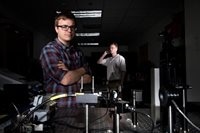Jan 24 2019
In a breakthrough study, scientists have demonstrated that an audible message can be transmitted to a person through a laser, without using any kind of receiver device.
 Ryan M. Sullenberger and Charles M. Wynn developed a way to use eye- and skin-safe laser light to transmit a highly targeted audible message to a person without any type of receiver equipment. (Image credit: Massachusetts Institute of Technology’s Lincoln Laboratory)
Ryan M. Sullenberger and Charles M. Wynn developed a way to use eye- and skin-safe laser light to transmit a highly targeted audible message to a person without any type of receiver equipment. (Image credit: Massachusetts Institute of Technology’s Lincoln Laboratory)
This potential to transmit highly targeted audio signals across the air can possibly be used for warning individuals of perilous situations like an active shooter, or for communicating across noisy rooms.
Scientists from the Lincoln Laboratory of the Massachusetts Institute of Technology have reported their findings in The Optical Society (OSA) journal Optics Letters, describing how two different laser-based techniques were used to send different recorded speech, music, and tones at a conversational volume.
Our system can be used from some distance away to beam information directly to someone’s ear. It is the first system that uses lasers that are fully safe for the eyes and skin to localize an audible signal to a particular person in any setting.
Charles M. Wynn, Study Team Lead, Lincoln Laboratory, Massachusetts Institute of Technology
Creating sound from air
The latest techniques are based on the photoacoustic effect, which takes place when a material absorbs light and forms sound waves. In this example, the scientists were able to absorb light and produce sound using water vapor in the air.
“This can work even in relatively dry conditions because there is almost always a little water in the air, especially around people,” stated Wynn. “We found that we don’t need a lot of water if we use a laser wavelength that is very strongly absorbed by water. This was key because the stronger absorption leads to more sound.”
One novel sound transmission technique emerged from a method known as dynamic photoacoustic spectroscopy, or DPAS in short, which was earlier developed by the researchers to detect chemicals. In the previous study, the team noted that chemical detection could be improved by sweeping or scanning a laser beam at the speed of sound.
The speed of sound is a very special speed at which to work. In this new paper, we show that sweeping a laser beam at the speed of sound at a wavelength absorbed by water can be used as an efficient way to create sound.
Ryan M. Sullenberger, Study First Author, Lincoln Laboratory, Massachusetts Institute of Technology
For the DPAS-related method, the scientists encoded different audible pitches or frequencies in the light by altering the duration of the laser sweeps. The laser sweeping method has one unique aspect—it is possible to hear the signal only at a specific distance from the transmitter, meaning that a message might be conveyed to an individual, instead of everyone who crosses the light beam. Targeting a message to numerous individuals is another possibility of this technique.
Laboratory tests
In the laboratory, the scientists demonstrated that with the help of the laser sweeping method, commercially available instruments can possibly transmit sound to an individual over 2.5 m away at 60 decibels. According to them, the system could even be scaled up easily to longer distances. The researchers also tested a conventional photoacoustic technique that encodes the audio message by modulating the laser beam’s power and removes the need for laser scanning.
“There are tradeoffs between the two techniques,” stated Sullenberger. “The traditional photoacoustics method provides sound with higher fidelity, whereas the laser sweeping provides sound with louder audio.”
The investigators are now planning to test the techniques outdoors at longer ranges. “We hope that this will eventually become a commercial technology,” Sullenberger said. “There are a lot of exciting possibilities, and we want to develop the communication technology in ways that are useful.”